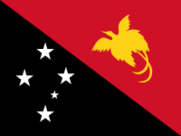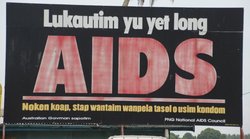Papua New Guinea

Lying just south of the equator, 160km north
of Australia, Papua New Guinea has
a total land mass of about 473.189sq.km.
The country encompasses the eastern side
of New Guinea Island - the second largest
island in the world, plus some 600 other
islands, atolls and coral reefs.
A central core of mountains, the Owen Stanley
Range, runs east to west, rising steeply
from the coastal plains. From its highest
peaks such as 4500 metre high Mt Wilhelm
and from downs of other peaks, rivers like
the Sepik (one of the world's longest
waterways) and Fly River begin their journey
to the sea. Below the mountain chain, fertile
coastal plains, flooded delta regions and
mangrove swamps exist alongside broad sandy
beaches, colourful sheltered bays and dense
rainforest.
Vast tracts of the country are wild and undeveloped.
The terrain has made it difficult for any
transportation infrastructure to be developed
and in some areas aeroplanes are the only
mode of transport – there are 492 airports.
A very small proportion of the land can sustain
cash crops, including coffee and cocoa. Abundant
rainforests provide the raw material for
a logging industry, which is dominated by
Malaysian-owned companies. Conservation groups
have criticised the social and environmental
impact of the activity. Kopra (coconut) oil
is produced in all areas along the East coast.
Mineral deposits - including gold, copper
and nickel - are extensive, but the difficult
terrain and poor infrastructure make exploitation
slow. There are significant reserves of oil
and natural gas and the country has pinned
its hopes on becoming a significant energy
exporter.
After being ruled by three external powers
since 1884, Papua New Guinea gained its independence
from Australia in 1975. It remains a British
Commonwealth realm.
People and Culture
The total population of almost 5.5 million
are comprised mainly of people from the Melanesian
race with more than a third of them in the
rugged Highlands. Some 80% of Papua New Guinea's
people live in rural areas with few or no
facilities of modern life. Most people live
on subsistence farming and fishing. Many
tribes in the isolated mountainous interior
have little contact with one another, let
alone with the outside world, and live within
a non-monetarised economy dependent on subsistence
agriculture. The concept of travel is unknown
– people believe that you use a boat
to go from A to B only.
Papua New Guinea has one of the highest incidences
of HIV and AIDS in the Pacific region and
it is on the rise. Some experts fear that
Papua New Guinea is heading for a crisis
similar to that in sub-Saharan Africa.
The traditional Melanesian cultures are kept
alive in elaborate rituals that accompany deaths,
feasts, marriages, compensation ceremonies
and initiation rites. Variations in village
construction, dialect and dress are common
in country areas while annual Sing Sing shows,
part of the Papua New Guinea Cultural Events
Calendar, see villagers from around
the country demonstrate their singing, dancing
and elaborate bilas (traditional costumes).
Politics
Parliament endorsed Peter O'Neill (former
finance minister) as prime minister in August
2012, drawing the line under a prolonged
political feud with his rival Sir Michael
Somare. The dispute had left Papua New Guinea
with parallel administrations as both men
were declaring themselves the rightful prime
minister ahead of national elections in June.
Known as "The Chief", Sir Michael,
the founding father of independent Papua
New Guinea, accepted the defeat of his National
Alliance Party in the poll and backed Mr
O'Neill's bid to form a government.
He said he would step down as party leader
but remain an MP.
Mr O'Neill was elected by MPs in August
2011 after Sir Michael was ruled ineligible
to be an MP owing to illness and absence
from the house. But the Supreme Court ruled
that Mr O'Neill's election was illegal
and that Sir Michael should be reinstated.
Parliament backed Mr O'Neill, defying
the court. Mr O'Neill faced a further
challenge to his authority in January 2012,
when a group of soldiers demanding Sir Michael's
reinstatement seized the military headquarters
in Port Moresby.
.
Future Challenges v Traditional Culture
Land ownership
Wantokism & cultural history
Compensation and payback
Good governance with law and order
Corruption and Nepotism
Wider Western Economy
Languages spoken 820
Languages spoken per adult 3
Major language: English, Tok Pisin, Hiri Motu
Indigenous counting systems More than 50 (one is based on joints of
the body and the nose)
Major religions: Christianity, indigenous belief
Monetary unit: 1 kina = 100 toea
|
Language
More than 800 local languages (in addition
to many minor dialects) exist in Papua
New Guinea – about a third of the world's
indigenous tongues. Pidgin (Tok Pisin) is
common to most Papua New Guineans and was
formed originally as a trading language.
It originates from the combination of English,
German, Malay and Portugese. It consists
of 1500 words, 22 letters of the alphabet
(no C, Q, X or Z) and 5 vowels. Most villagers
that we encountered could speak their local
language, Tok Pisin and had a good command
of the English language.

Land
The PNG Constitution expresses the wish for
“traditional villages and communities
to remain as viable units of Papua New Guinean
society”, and for active steps to be
taken in their preservation. Laws exist in
which a type of tenure called ‘customary
land title’ is recognised. This customary
land notionally covers about 97% of the usable
land in the country. The remaining ‘alienated’
land is either held privately under State
Lease or is government land. Freehold title
can only be held by Papua New Guinea citizens.
Climate
Papua New Guinea has a warm to hot and humid
climate throughout the year. Each province
experiences a rainy season, in the summer
months, which varies from province to province.
The country is at its driest from May to
December.
Media
Radio is important in Papua New Guinea, which
has scattered, isolated settlements and low
levels of literacy.
The government operates a national network
and provincial stations. News coverage is
said to be balanced. But funding problems
have taken some regional radios off the air.
BBC World Service and Radio Australia broadcast
on FM in the capital, Port Moresby.
Television coverage is limited mainly to
Port Moresby and the provincial capitals.
Two daily newspapers are foreign-owned. The
private press, including weeklies and monthlies,
reports on corruption and other sensitive
matters.
By June 2010 there were 125,000 internet
users (InternetWorldStats) with an increasing
blogging scene. Radio Australia says the
platform gives locals a chance to vent their
frustration with politicians, bureaucrats
and the police. Social media - including
blogs, Facebook and Twitter - emerged as
platforms for debate during elections in
2012. One blogger observed that smartphone
use was ironing out disparities in social
media access between rural and urban voters.
|
History
Originally known as the Ilasdos Papios –
Island of the fuzzy hair. In 1600 a map was
published calling it Nova Guinea.
During WWII the Japanese occupied Rabaul
in 1942, working their way south through
the country to within 50km of Port Moresby.
The battle for Milne Bay in September, 1942
was the first time in the Pacific war of
1941-45 that the Japanese were defeated on
land. The first time also that the Australian
Army and Airforce fought side by side and
the first time the US troops fought in Papua
New Guinea. The Bismark Sea, to the north
of Papua New Guinea, was the site of the
1943 Battle of the Bismark Sea which was
a major Japanese naval defeat during WWII
in which planes of the US 5th Air Force and
the Royal Australian Air Force attacked a
Japanese convoy carrying about 105,000 troops
from China and Japan to Lae (PNG) resulting
in heavy losses for the Japanese. It took until 1945 to regain all the mainland
from the Japanese.
The separatist struggle in the neighbouring
Indonesian province of Papua, formerly known
as Irian Jaya, prompted the flight of thousands
of Papuans into Papua New Guinea from the
mid-1980s onwards. Many of them remain in
border-area jungle camps. The Papua New Guinean government has
said it will not tolerate the use of its
territory for separatist attacks on the Indonesian
army.
Papua New Guinea had to deal with separatist
forces of its own on the island of Bougainville
in the 1990s. Up to 20,000 people were killed
in the nine-year conflict which ended in
1997. A peace deal signed in 2001 provided
the framework for the election in 2005 of
an autonomous government for Bougainville.
Bourganville is part of the Solomon Islands
and has a very rich copper mine. Australia
gave Bourganville to the Papua New Guineans
so they could use the funds from the mine
to develop Papua New Guinea. However, the
Bourganvillians wanted their own independence.
In 1989 they closed the mine and in 1990
declared independence, which was not recognised.
Papua New Guinea spent a lot of money fighting
the civil war in Bourganiville and it divided
the tribes for many years.
In 1996 the government of Sir Julius Chan
hired mercenaries to try to crush the separatists.
What became known as the Sandline Affair
was a disaster, but ironically the fall-out
brought world attention to the conflict and
forced the protagonists to find peaceful
solutions with the help of talks brokered
by New Zealand and Australia. In 2002 the
PNG Government provided autonomy arrangements
with guarantees of a referendum for independence
by 2020.
Papua New Guinea has strong ties with its
southern neighbour, Australia, which administered
the territory until independence in 1975.
Canberra's substantial aid programme
aims to relieve poverty and to boost development.
Australia has also despatched police officers
and civil servants to support their local
equivalents. |
|















